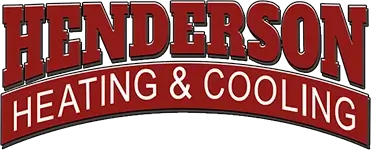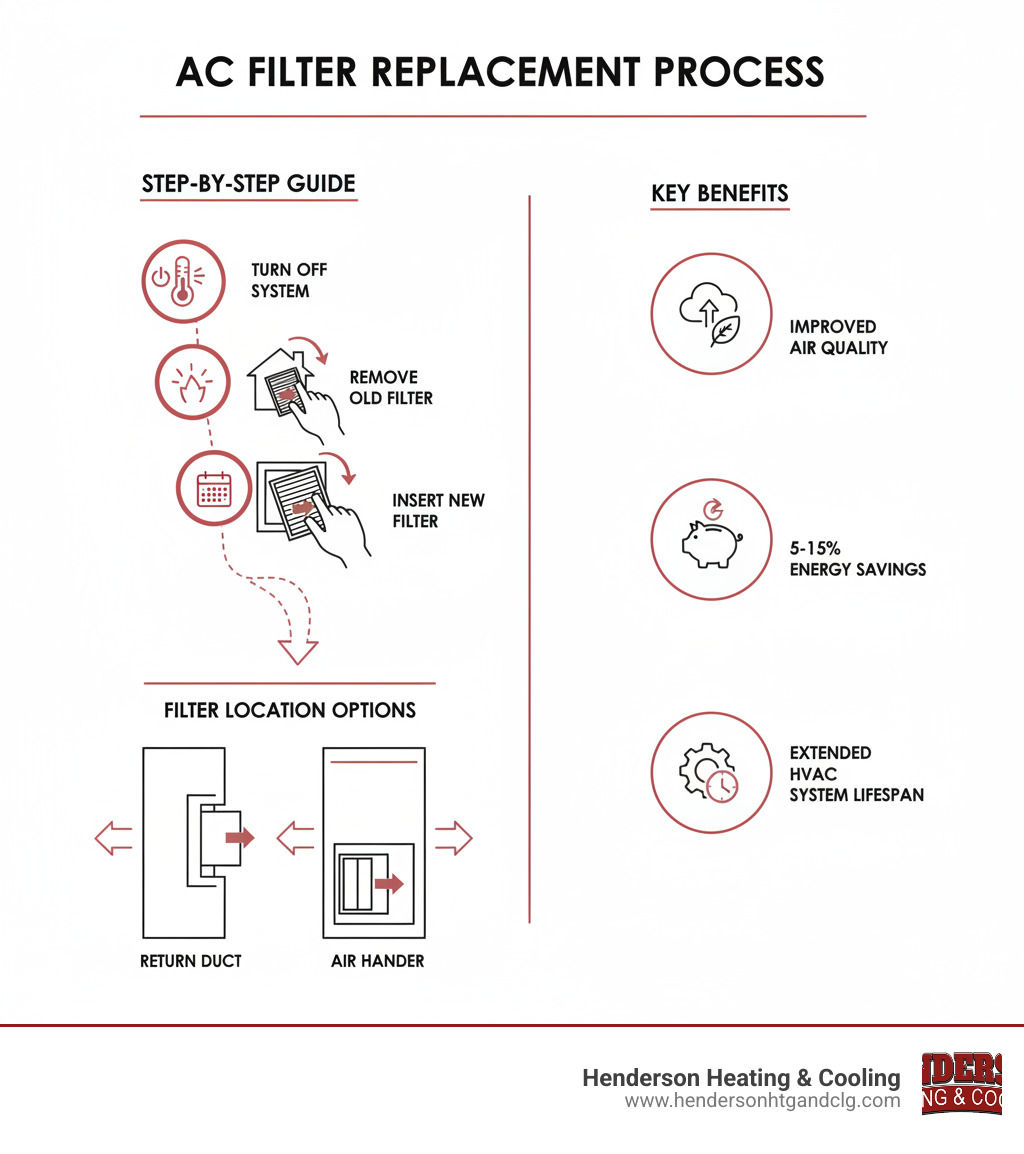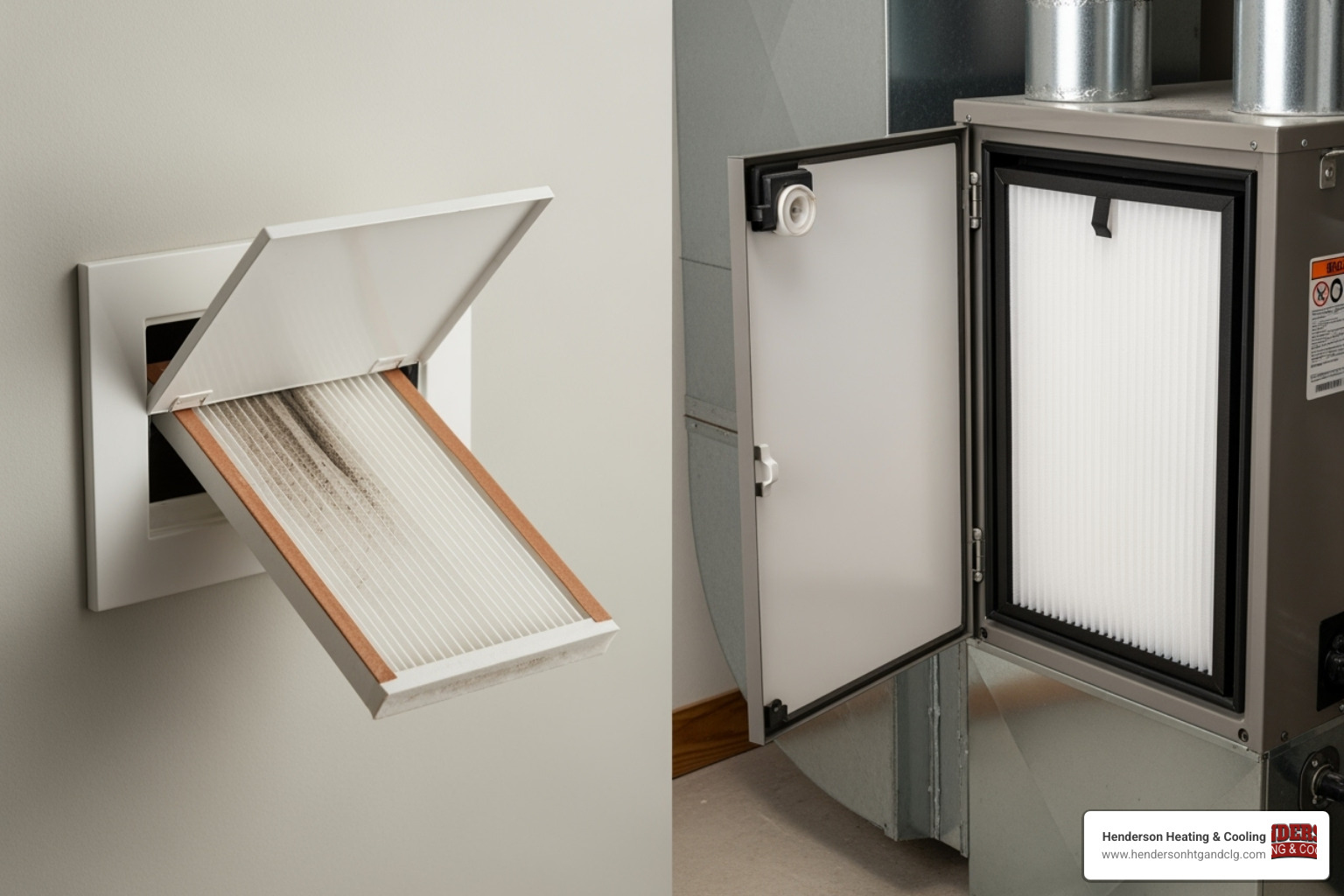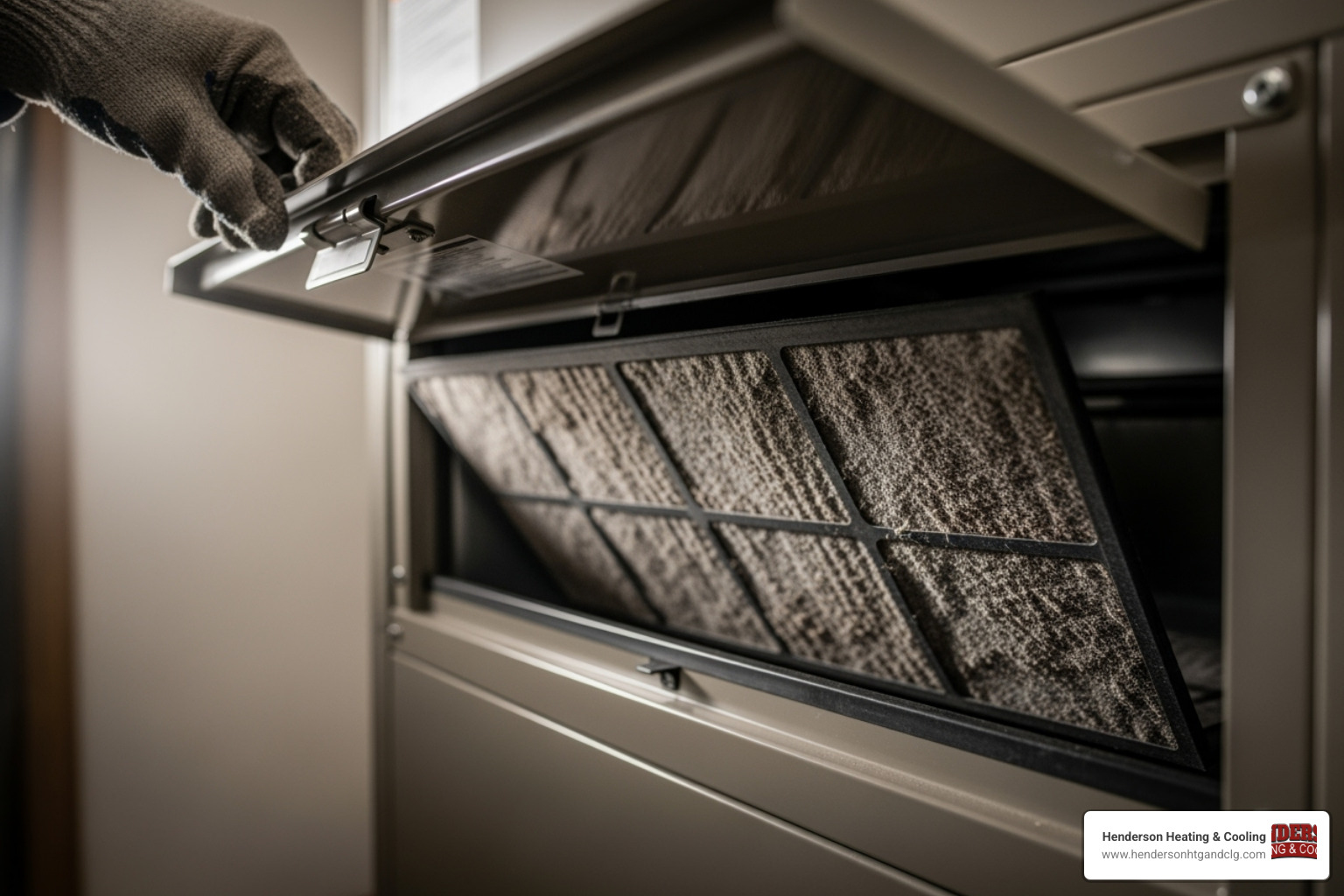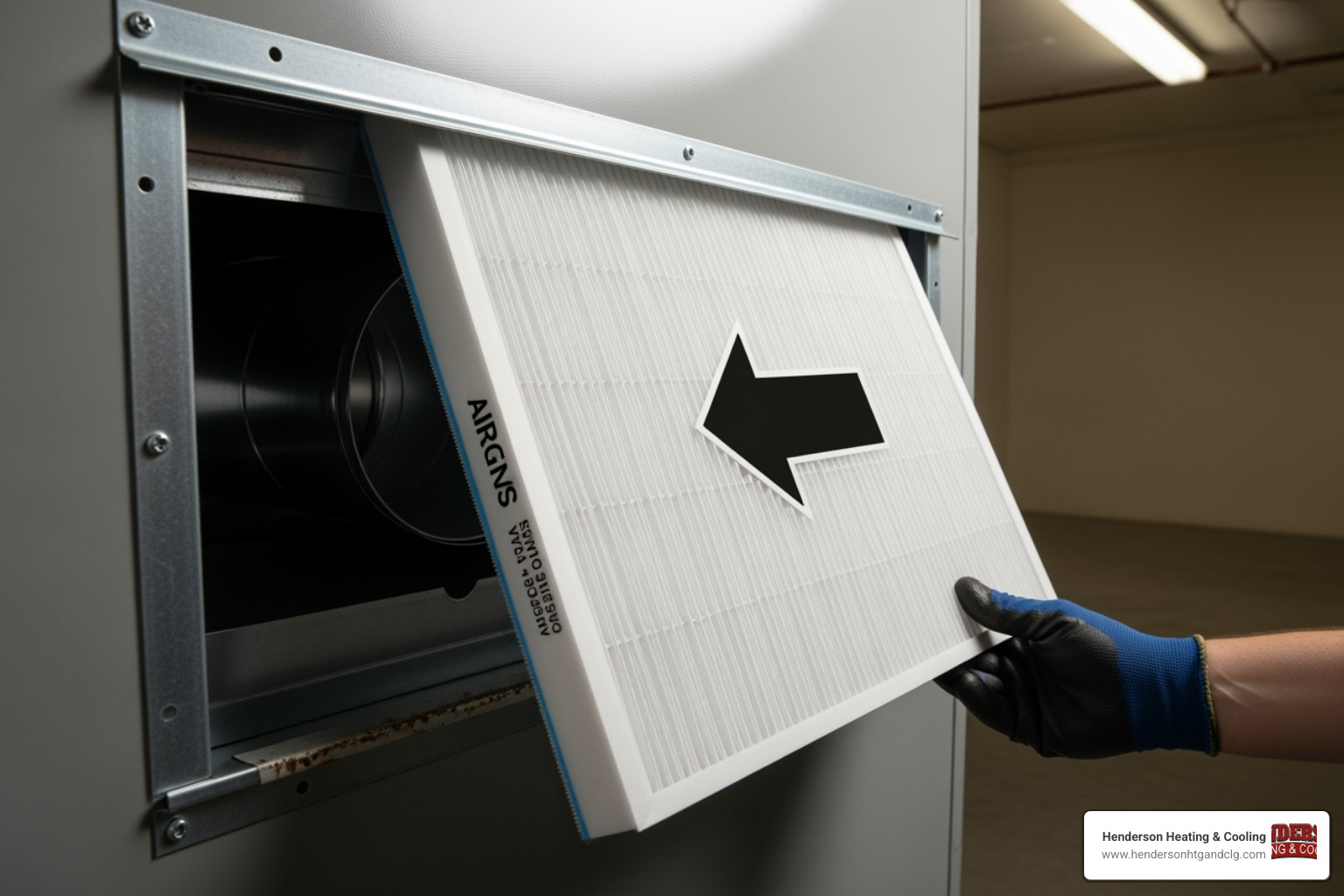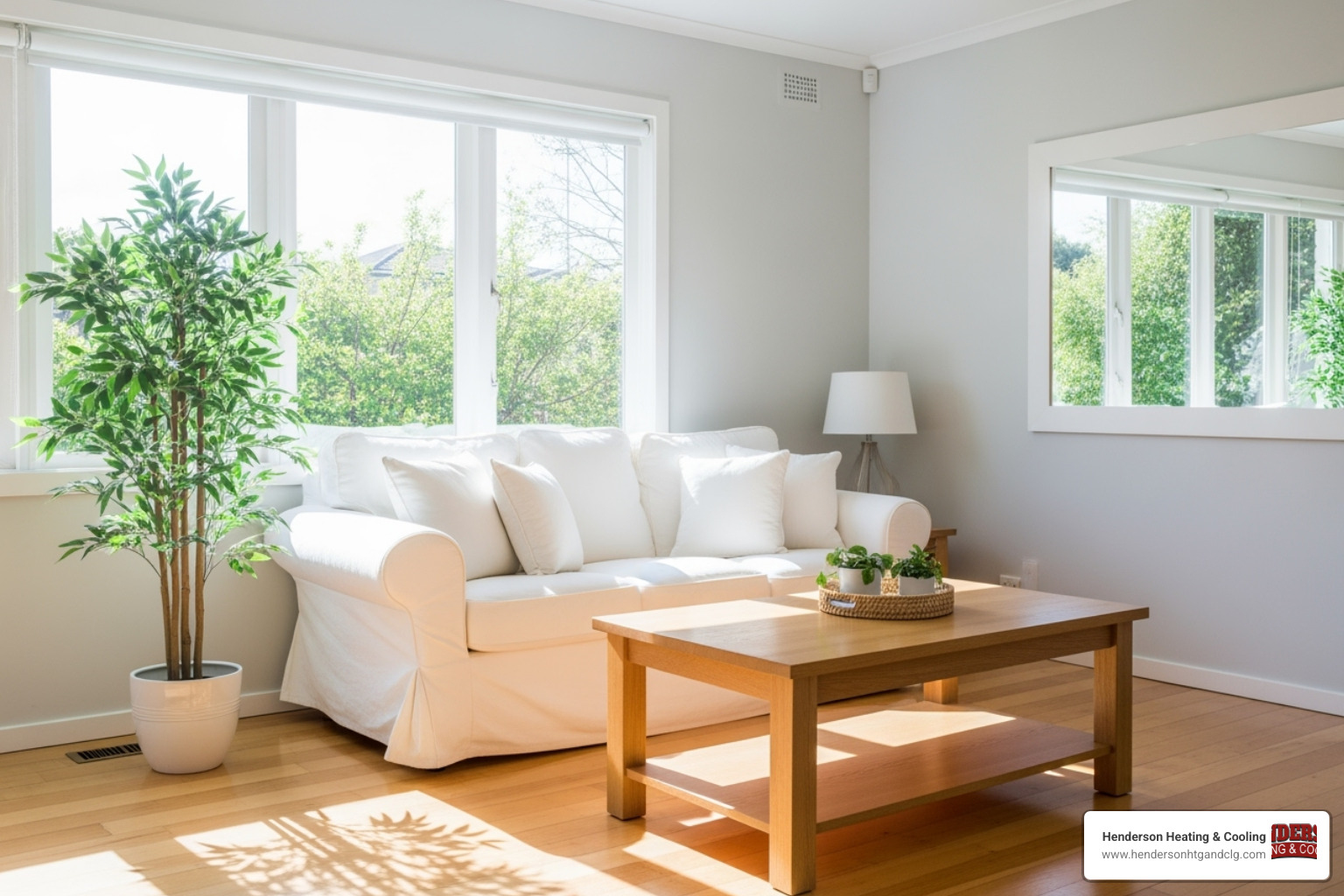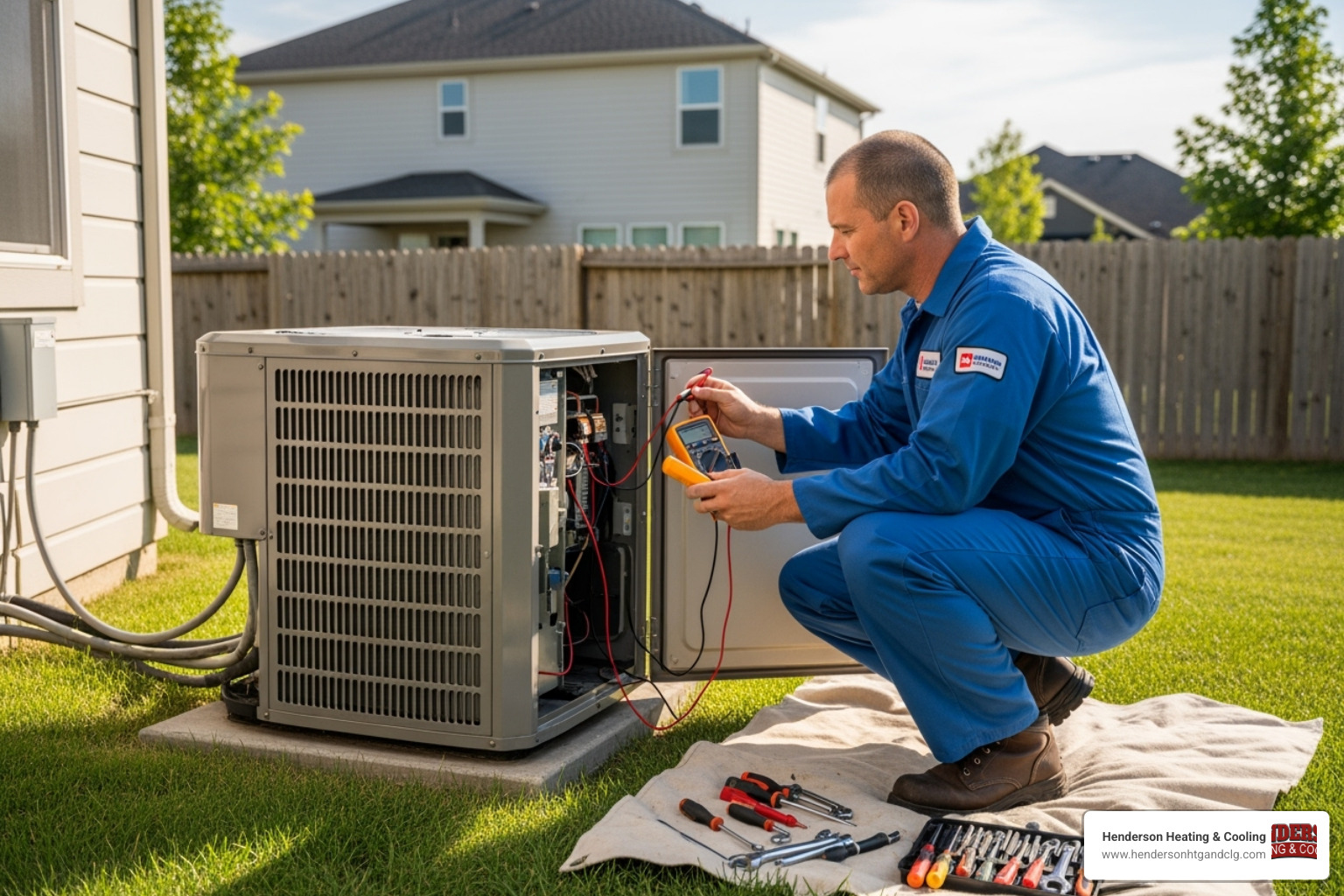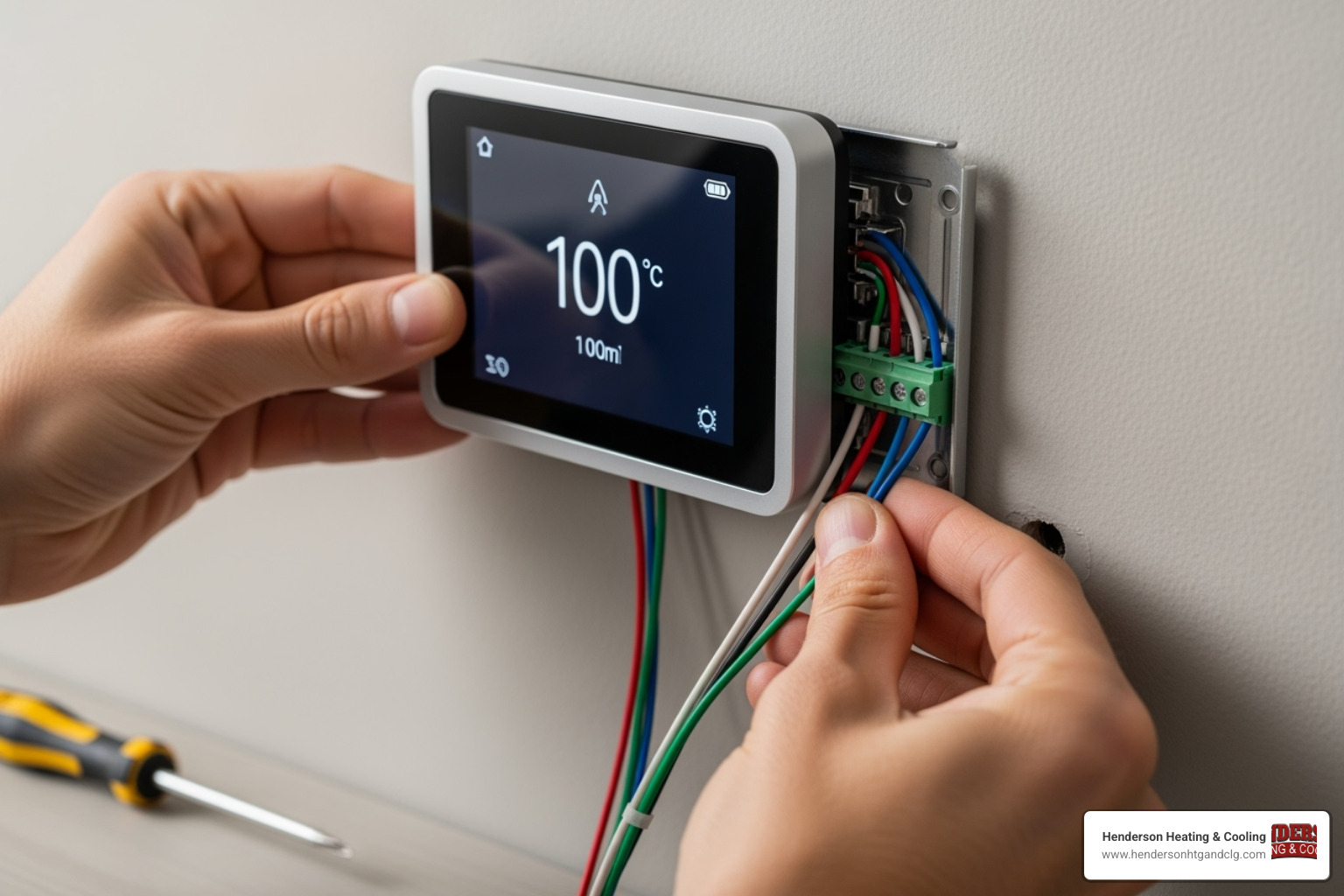Why Your AC Filter Matters More Than You Think
AC filter replacement is one of the simplest yet most important maintenance tasks for your home’s comfort system. This quick DIY job delivers major benefits for your family’s health and your wallet.
Quick AC Filter Replacement Steps:
- Turn off your HVAC system at the thermostat
- Locate the filter in your return air duct or air handler
- Remove the old filter and note the airflow arrow direction
- Insert the new filter with arrows pointing toward the unit
- Restore power and mark your calendar for the next change
Regular filter changes can reduce your energy bills by 5-15%, according to the Department of Energy. Clean filters trap dust, pollen, and pet dander, making the air you breathe cleaner and healthier.
Most homeowners should replace their filters every 1-3 months, though homes with pets, smokers, or allergy sufferers may need more frequent changes. You don’t need special tools or technical skills to get it done.
A dirty, clogged filter forces your system to work harder, leading to higher energy bills and potential breakdowns. A fresh filter keeps air flowing smoothly, protects your equipment, and maintains consistent comfort in your Southwest Missouri home.
Why Regular Filter Changes Are Crucial for Your Home
Your home should be a sanctuary, but indoor air can be two to five times more polluted than outdoor air, according to Studies by the US Environmental Protection Agency. Your AC filter is your home’s hero, trapping dust, pollen, pet dander, and mold spores. Staying on top of AC filter replacement gives your family cleaner, healthier air.
Your wallet will thank you, too. A dirty filter forces your HVAC system to work overtime. The US Department of Energy states that replacing a clogged filter can boost efficiency by 5-15%, saving you money.
Regular AC filter replacement also protects your HVAC system. It catches dust and debris before they can coat coils or clog the blower motor, leading to fewer repair calls, longer equipment life, and smoother operation.
For those with allergies or asthma, a clean filter is a game-changer, removing the pollen, pet dander, and dust mites that trigger symptoms. Many customers notice a difference within days of a filter change.
Signs You Need an AC Filter Replacement
Your HVAC system has ways of asking for a fresh filter. Here are the warning signs:
- Visible dirt: The most obvious clue is the filter itself. If you can’t see light through it, it’s time for a change.
- More dust: Noticing more dust on furniture? When your filter is overwhelmed, particles bypass it and settle in your home.
- Strange smells: Musty odors from vents are a red flag. A clogged filter can breed mold and mildew.
- Weaker airflow: If airflow from your vents feels weak, a clogged filter is often restricting air movement.
- Higher energy bills: An unexplained spike in energy bills can point to a dirty filter forcing your system to work harder.
- Allergy flare-ups: If your family experiences more allergy symptoms indoors, your filter may no longer be effective.
- Short-cycling: This is when your AC turns on and off in frequent, short bursts. As noted in our guide on Signs Your HVAC System Requires Repair, a dirty filter is a common culprit.
The Consequences of Neglecting Your Filter
Skipping filter changes can lead to big, expensive headaches. Here’s what can happen:
- Frozen evaporator coils: A clogged filter restricts airflow over the coil, causing moisture to freeze into a block of ice. This prevents cooling and can damage your system.
- Overheating: Restricted airflow causes overheating, straining the blower motor and other components. This leads to premature failure.
- Poor cooling performance: The system can’t move enough air to keep your home comfortable, leaving you warm and frustrated.
- Ductwork contamination: When severely clogged, dirty air can bypass the filter and flow into your ductwork, contaminating the air distribution system.
- Increased energy use and damage: The 5-15% increase in energy consumption adds up. Extreme neglect can cause permanent system damage requiring major repairs or replacement. A dirty filter is often the cause when your AC Not Blowing Cold Air? Tips.
Fortunately, these problems are preventable with regular AC filter replacement, which protects your comfort, health, and HVAC investment.
A Step-by-Step Guide to AC Filter Replacement
Ready for your first AC filter replacement? It’s a simple DIY task that requires no special tools, just a few minutes and attention to detail. The process takes about five minutes, and your HVAC system will reward you with cleaner air and lower energy bills.
Step 1: Turn Off Your HVAC System
Safety first. Before you start, head to your thermostat and switch it to the “Off” position. This stops the system from running while you work and prevents potential damage. For extra safety, you can also flip the HVAC system’s circuit breaker in your electrical panel.
Step 2: Locate and Remove the Old Filter
Your AC filter is in one of two common spots. Many homes have the filter behind a large grille on a wall or ceiling, which is the return air duct. If not there, check your air handler cabinet (often in a closet, basement, or attic) for a designated filter slot.
Once found, open the access panel and slide the old filter out. Before discarding it, note the filter size and the airflow arrow direction printed on its frame.
Step 3: Insert the New Filter
Proper installation is key. First, match the size exactly, as an incorrect size will allow dirty air to bypass the filter. Next, find the airflow arrow on the new filter. It must point in the same direction as the old one—toward the furnace or air handler.
Gently slide the new filter into the slot until it fits snugly. Don’t force it; if it’s difficult to insert, double-check the size and orientation.
Step 4: Close Up and Restore Power
You’re almost done. Replace the access panel and ensure all latches are secured to prevent air leaks. Then, return to your thermostat and turn the power back on (and flip the circuit breaker if you turned it off).
Pro tip: Use a pen to record the replacement date on the new filter’s frame as a reminder. For more maintenance tips, see our guide on How to Maintain Your Air Conditioner.
Congratulations! You’ve completed your AC filter replacement and improved your home’s air quality and efficiency.
Choosing the Right Filter for Your System
Choosing the right filter means balancing effective air cleaning with good airflow for your HVAC system. Your home’s needs—like having pets or family members with allergies—will determine the best choice. For a deep dive, see our Comprehensive Guide to Home Air Filters.
Understanding Filter Types
Here are the main types for your AC filter replacement:
- Fiberglass filters: These budget-friendly filters (MERV 1-4) primarily protect HVAC equipment from large debris. They require monthly replacement and offer maximum airflow.
- Pleated filters: A popular choice (MERV 5-13), these offer a great balance of particle capture and airflow. Their pleated design traps more pollen, pet dander, and mold spores, and they typically last 60-90 days.
- Washable/Electrostatic filters: These reusable filters (MERV 1-4) use static electricity to grab particles. They are eco-friendly but require monthly cleaning and must be completely dry before reinstallation to prevent mold.
- HEPA filters: These high-efficiency filters (MERV 14-16+) capture 99.97% of tiny particles, including bacteria. However, their high resistance to airflow can be too restrictive for most residential HVAC systems.
- Activated carbon filters: Often combined with pleated filters, these are your secret weapon against odors from pets, cooking, or smoke.
The choice between disposable and reusable filters comes down to convenience versus maintenance. Disposables are easy to toss and replace, while reusables appeal to those who don’t mind the cleaning effort.
Decoding MERV Ratings
MERV (Minimum Efficiency Reporting Value) rates a filter’s ability to capture particles on a scale of 1-16. Higher numbers mean better filtration, but more isn’t always better for your system.
- MERV 1-4: Basic protection for your equipment, stopping only large particles.
- MERV 5-8: A good step up, capturing common allergens like pollen, dust mites, and pet dander.
- MERV 8-12: The sweet spot for most homes, especially those with pets or allergies, providing excellent filtration without overly restricting airflow.
- MERV 13-16: Hospital-grade filtration that can be too restrictive for many residential systems, potentially causing strain and damage.
The goal is to balance filtration with airflow. A filter that’s too restrictive forces your system to work harder, leading to inefficiency and premature wear.
How to Find the Correct Size for Your AC Filter Replacement
Getting the right size is crucial. An ill-fitting filter allows dirty air to bypass it.
- Check the old filter: The dimensions (length x width x thickness) are usually printed on the cardboard frame. Take a photo for reference.
- Measure it: If the numbers are gone, use a tape measure to check the length, width, and thickness of the filter itself.
- Consult your HVAC manual: The manual will specify the correct filter size for your system. If you can’t find it, give Henderson Heating & Cooling a call, and we’ll help you find the right filter for your Southwest Missouri home.
Frequently Asked Questions about AC Filters
We get a lot of questions about AC filters from homeowners across Southwest Missouri. Here are answers to the most common ones.
How often should I replace my air filter?
The frequency of AC filter replacement depends on your home. The general rule is every 90 days, but consider these factors:
- Pets: With pets, check your filter monthly and plan to replace it every 30-60 days to handle the extra dander and fur.
- Smokers: In smoking households, monthly replacement is essential to manage smoke particles and maintain air quality.
- Allergies or Asthma: For allergy or asthma sufferers, monthly checks and frequent changes can significantly improve indoor comfort. Consider a MERV 8-12 filter for better particle capture.
- Environment: During high-pollen seasons or if you live near a construction zone, your filter works harder. Check it monthly.
- System Usage: The more your HVAC system runs, the faster the filter gets dirty. During peak summer and winter months, you’ll need to change it more often.
Can I clean and reuse my air filter?
It depends on the filter type. Most standard fiberglass and pleated filters are disposable and should not be washed, as it damages the filter media.
However, washable electrostatic filters are designed for reuse. To clean one:
- Gently vacuum or brush off loose debris.
- Rinse it thoroughly with water, sometimes against the direction of the airflow arrow to dislodge particles.
- Let it air dry completely. This is crucial. Reinstalling a damp filter can lead to mold and mildew growth in your system.
Even washable filters need to be replaced every 1-5 years, or when the material looks damaged or permanently stained.
What happens if I install the filter backward?
It’s an easy mistake to make, but installing a filter backward can cause problems. The airflow arrow indicates the direction air must travel for proper filtration.
- Restricted Airflow: A backward filter makes your system work harder, increasing energy use and straining the blower motor.
- Reduced Effectiveness: The filter won’t trap particles efficiently, allowing dust and allergens to circulate through your home.
- Potential Collapse: In some cases, the filter can collapse under the incorrect air pressure, allowing unfiltered air to bypass it completely.
To avoid this, always double-check that the arrow points toward the furnace or air handler before closing the access panel.
Keep Your System Running Smoothly
Congratulations on mastering AC filter replacement! By performing this simple DIY task, you’re taking charge of your family’s comfort and health while protecting your HVAC investment.
In just a few minutes every couple of months, you can create cleaner air, reduce energy bills by up to 15%, and help your HVAC system run smoothly for years. Regular filter changes are the foundation of a well-functioning system, ensuring it serves you reliably through Missouri’s hot summers and chilly winters.
Of course, some issues require professional help. If you notice refrigerant leaks, electrical problems, strange noises, or poor cooling despite a fresh filter, it’s time to call in the experts.
At Henderson Heating & Cooling, we serve homeowners throughout Southwest Missouri, including Lebanon, St. Robert, and Camdenton. We specialize in reliable heating and cooling solutions, particularly Daikin systems that come with 12-year warranties and our Comfort Promise for your complete satisfaction.
Whether you need a repair, a tune-up, or just have questions, we’re here to help you breathe easier and stay comfortable all year long.
If you need professional AC repair in Lebanon, MO, contact our experts
